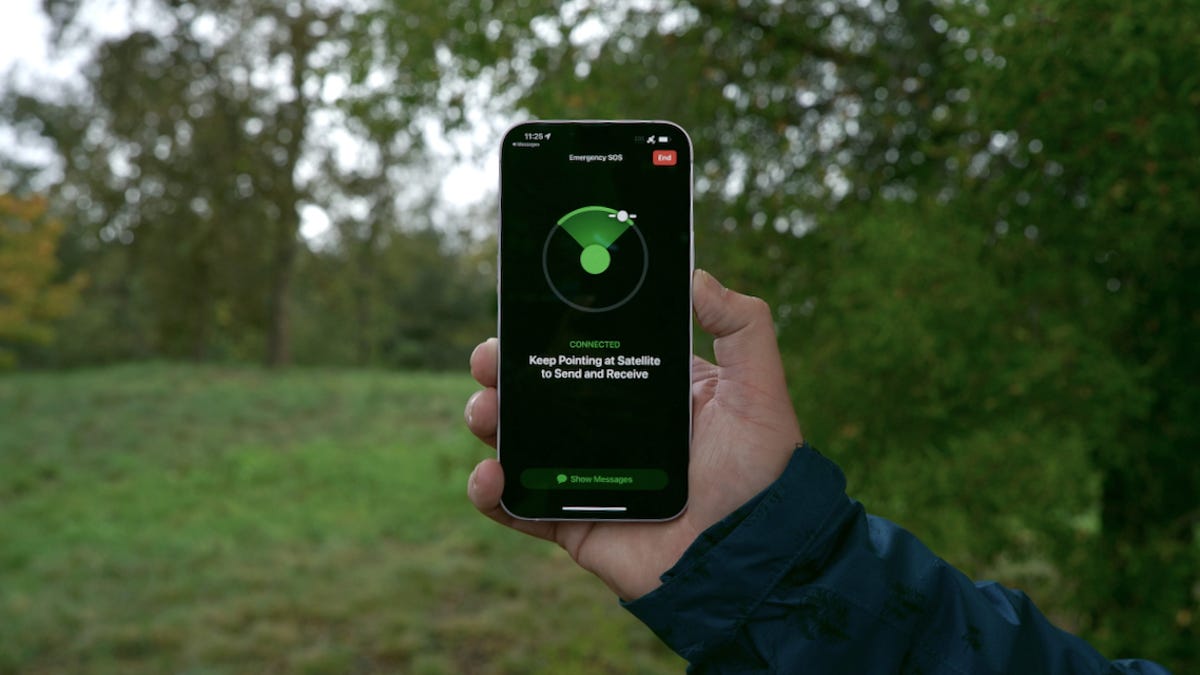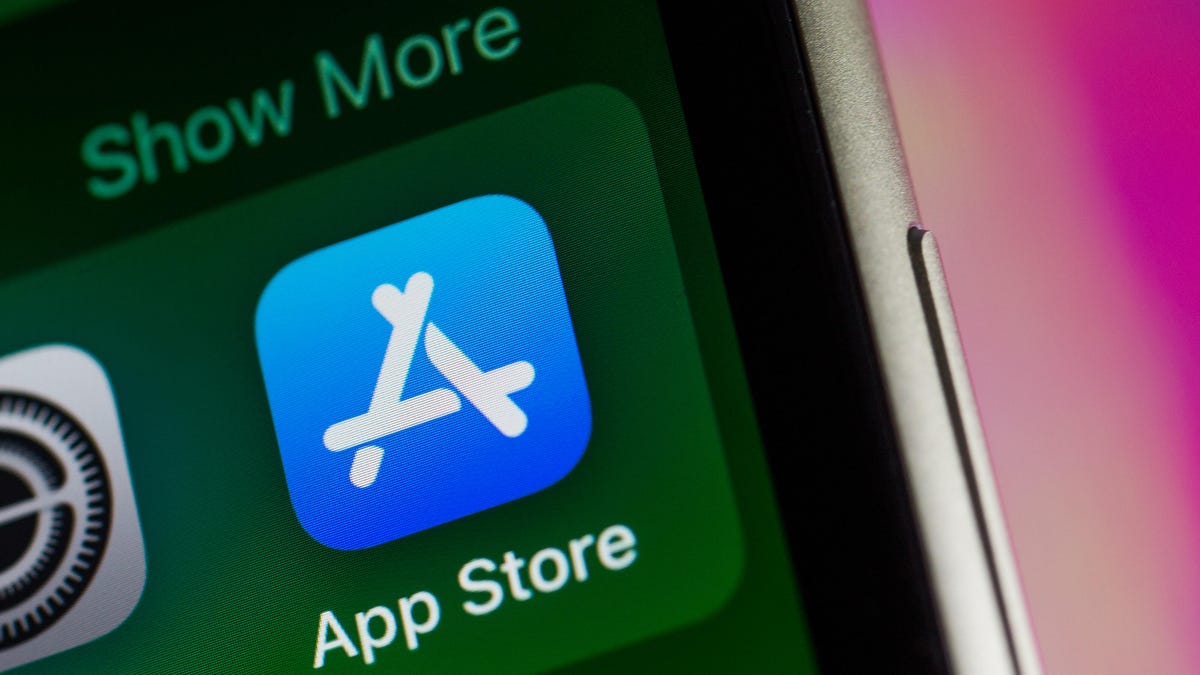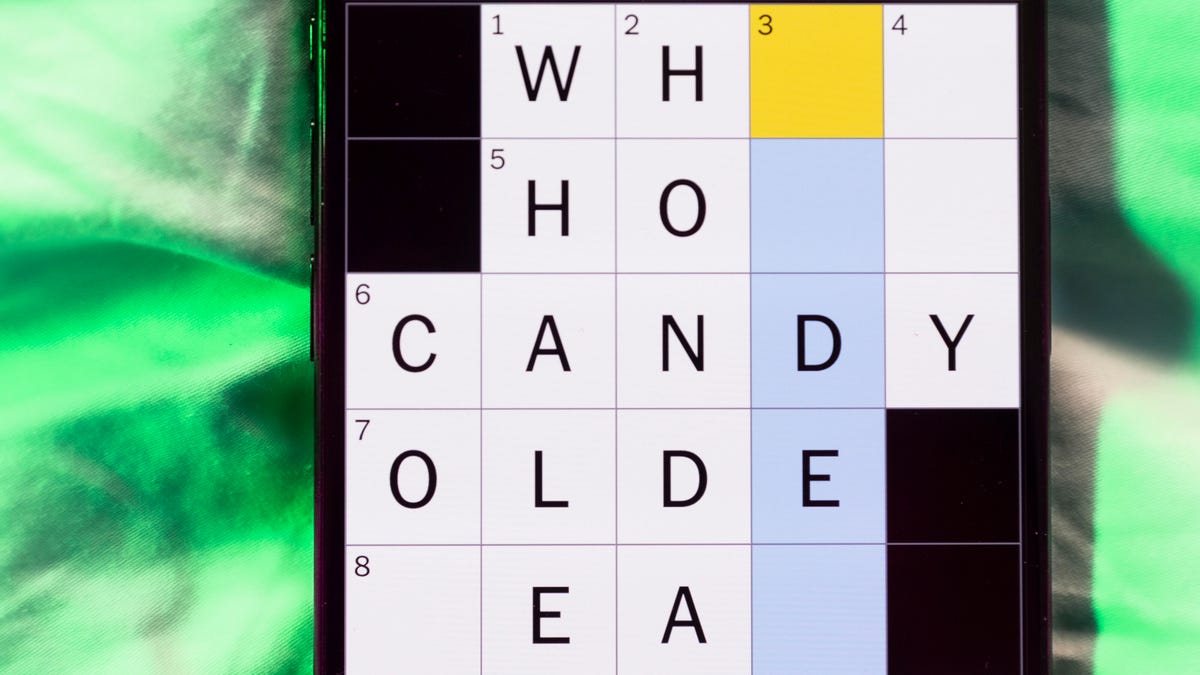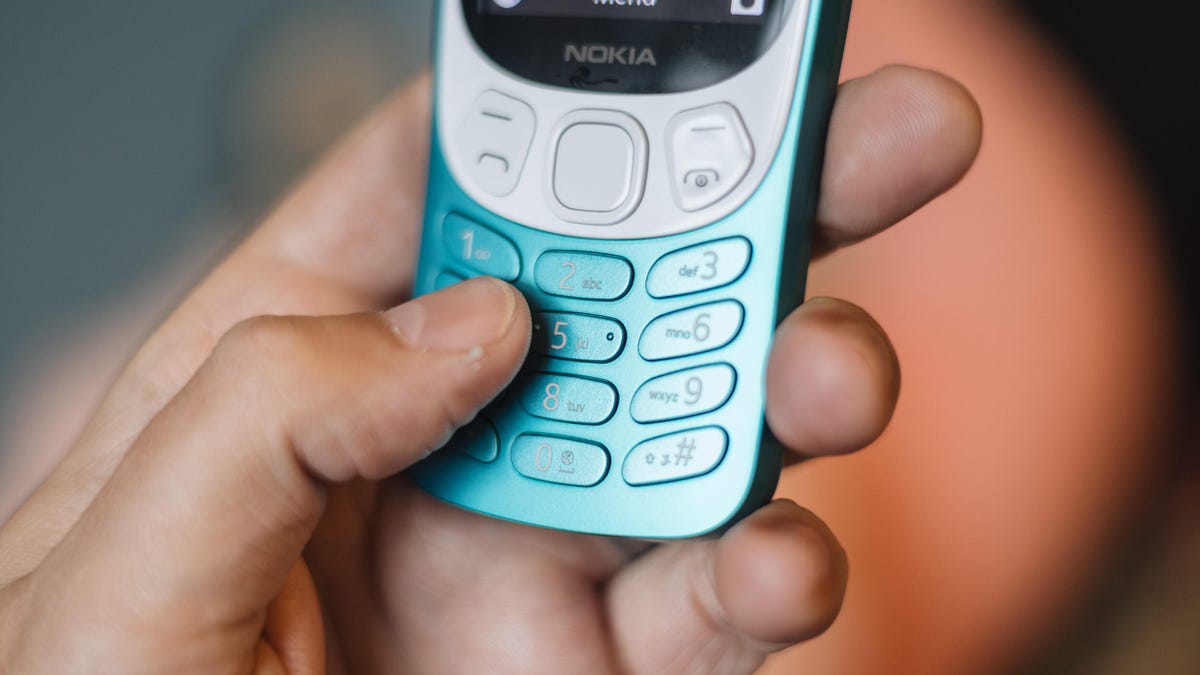Technologies
iPhone 14 Sets the Stage for 2023’s Biggest Phone Trend
Everyone’s jumping on the idea of texting through orbiting satellites, but is it just a fad?

The next time you find yourself needing to send a text while stuck in the middle of nowhere, you may be able to look to the sky, where low-Earth satellites can help send an SOS, no matter what device you have.
Last year, Apple became the first tech company to offer new satellite texting capabilities to its devices, introducing it with the iPhone 14 as a system to call for help in emergencies. The idea is easy enough: Point your phone at the sky, line it up with a satellite passing overhead and send a text to authorities. You can even send GPS data too.
Now, other companies are poised to jump on board, making satellite texting a new frontier for the phone world.
«I think 2023 is certainly shaping up to be the year of mobile satellite connectivity,» said Avi Greengart, an analyst at research firm Techsponential. «Everyone’s doing it. Everyone is doing it differently.»
Sadly, it’s not as easy as adding a satellite texting app and an extra satellite radio to the phone. Low Earth-orbiting satellite systems cost money to run and maintain, just like cellular internet and phone systems do. Apple has said it’ll give iPhone owners free access to emergency services for two years after they buy their device, but it hasn’t said what happens after. Other satellite texting systems haven’t launched yet and seem likely to charge users for the privilege.
There’s no debate about whether this technology can be useful. We’ve already heard stories of people’s lives being saved because of it. The question is whether people are willing to pay for it. And if not, will satellite texting be just another fad, like 3D TV?
Currently, satellite tech on our phones is only for emergencies and only in expensive smartphones like Apple’s iPhone 14, which starts at $799. That makes the technology a nice-to-have feature that the broader population of phone owners won’t have access to for some time. Those that do may never end up in a dire situation without signal when the feature would come in handy — a group that IDC research director Nabila Popal counts herself among. «I can’t remember the last time I didn’t have cell service,» Popal said.
Given satellite texting’s niche use, Popal doesn’t believe having it will sway consumers into buying one phone over another. It will certainly appeal to backcountry hikers, desert drag racers and remote truckers who plan to head beyond cell networks. But, for everyone else, it’s not an important enough feature to rush out to buy.
Instead, it’s more like one more feather in the cap of modern smartphones, which have already bundled together so many other technologies we used to have to carry separately in our bags, like cameras and handheld video games.
The current state of satellite texting
Satellite phones have been around for decades, showing up in films as far back as Steven Seagal’s 1992 classic military thriller Under Siege whenever someone needs to make calls from the middle of the ocean. A satellite phone also played a critical role in getting people off dinosaur-infested island in 2001’s Jurassic Park III.
«Where’s the phone? Get the phone!» yells veteran dino survivor Alan Grant as it nearly slides off a boat and into a river during a Spinosaurus attack. (Spoilers, he grabs it at the last minute and is able to signal for help.)
The real-life versions aren’t as exciting, but they can be just as helpful. They use networks of dozens of satellites orbiting the Earth every 90 minutes or so to relay phone signals to the ground. The first of these systems was Iridium, which launched its service in 1998 and a dozen other satellite networks have survived by offering connectivity to frequent travelers, but the prospect became popular recently after Elon Musk’s rocket startup SpaceX borrowed the idea to surround the globe with internet coverage through its Starlink program.
You can still get satellite phone coverage by purchasing a bulky, nearly $900 feature phone and paying a premium of at least $50 for 5 minutes of call time for service from companies that own a private network of satellites. But phone makers are building in the capability to use those orbital networks to send emergency texts because smartphone radios have gotten good enough to communicate with satellites directly, instead of relying on a separate — and often large — antenna.
Phone radios have «gotten so good now that you can build satellite connectivity into a phone without needing an external antenna,» said Anshel Sag, an analyst at Moor Insights & Strategy.
Among mainstream smartphone makers, Apple was the first with its iPhone 14 line. The company partnered with GlobalStar, which has limited coverage of the US, Europe, Australia and limited parts of South America. Apple only activates this feature in a handful of countries in those continents, and it only works for emergency text messages made outside (it won’t reach deep within buildings), but the company pledged that new iPhone 14 owners get two years of service included when they buy the phone.
Earlier this month, Qualcomm revealed a new feature coming in Android phones that will let users send and receive text messages through satellites. It uses the Iridium network and Qualcomm says it will have global coverage, which is more than Apple’s services says.
The service, called Snapdragon Satellite, will only be for emergencies to start but will eventually be able to exchange messages socially and even use data, likely as part of a premium service. It’s not available yet and will come in phones launching in the second half of 2023 that use Qualcomm’s latest premium chips, though the company is leaving it up to phonemakers whether to have the service at all in their phones or if they should charge for the privilege. That leaves lots of unknowns.
And there are smaller players with their own niche devices, like Bullitt, which announced its Motorola-branded rugged phone powered by a MediaTek chipset at CES 2023 that will launch in the first quarter of 2023 for an undisclosed price tag. Bullitt promises two-way satellite texting through connectivity partner Skylo, which leases time on existing satellite constellations. Huawei actually launched its Mate 50 series of phones with satellite texting through China’s BeiDou satellite network a day ahead of Apple’s iPhone 14 debuted, though Huawei’s reach has diminished over the years.
More individual phones coming out with their own ideas of satellite texting will likely follow, and the big US carriers have all selected their own satellite partners to eventually offer mobile service beyond their networks’ edges, though none has a firm launch date yet.
Everyone’s in on the race because they can see the potential value of providing satellite safety nets as a service, analysts say. Apple could easily add it alongside its subscription services, like the $7 per month Apple TV Plus, $10 per month Apple Music Plus or $17 Apple One bundle. Carriers could use it to sweeten the deal for the priciest subscription plans, betting that the risk-averse among us are willing to pay extra for peace of mind. «It’s hard to overstate how important telling someone you’re out of gas in the middle of the Gobi Desert or Death Valley or the Adirondacks is,» Techsponential’s Greengart said.
Is it a bad thing to be the new phone trend?
Of course, the phone industry doesn’t have the best track record with new technologies. Analysts broadly consider the last couple years of transition to 5G wireless to have been a letdown, particularly because coverage has been spotty and speeds are sometimes as slow as the 4G LTE service we’ve had for years.
Satellite texting could be even more finicky than 5G was, particularly because it depends on the availability of satellites and the yet-untested strain of having many people relaying help requests through them.
Still, early signs seem promising. At CES 2023, Qualcomm took journalists outside Las Vegas to test its Snapdragon Satellite feature, and it worked. CNET phone editor Patrick Holland tested Apple’s Emergency SOS feature on his iPhone 14 and found that it worked — in fact, anyone can try it out without sending an emergency message thanks to a demo mode in the phone’s settings.
This seems like the next frontier — to use satellites to bolster mobile networks and keep people in contact. Even if most people will never have the misfortune to need it, the feature still acts as a safety net, helping the more adventurous phone users who wander beyond cell towers or disaster survivors after mobile networks fail.
Some iPhone 14 owners have reportedly been saved already thanks to the feature, including one man stranded when traveling by snow machine in Alaska above the Arctic Circle. In another case, a couple tumbled down into a deep canyon in a Los Angeles forest and used an iPhone to send for help. In less than 30 minutes, they were rescued. Without the iPhone’s satellite texting feature, emergency services wouldn’t have been contacted, and «nobody would have known to look for them,» Los Angeles County Sheriff Sgt. John Gilbert told The Los Angeles Times.
We’ve come a long way from needing to buy big, clunky satellite phones if we want to venture safely beyond the range of cell networks. Pretty soon, many smartphones will be able to call for help, whether you’ve taken a wrong turn in the wilderness or been attacked by dinosaurs on a remote island that you should have just stayed away from.
Technologies
Judge Blocks Texas App Store Age-Check Law
A preliminary injunction found the Texas law, set to begin Jan. 1, is «more likely than not unconstitutional.»

A new Texas state law set to take effect on Jan. 1 would have required app stores to implement age verification processes. But the law has been put on hold, at least temporarily, by a federal court judge.
As reported by the Texas Tribune, Senate Bill 2420, also known as the Texas App Store Accountability Act, is the subject of a temporary injunction issued by US District Judge Robert Pitman.
Pitman said in his decision that the law as written is broad, vague and «more likely than not unconstitutional.» However, he also wrote the court «recognizes the importance of ongoing efforts to better safeguard children when they are on their devices.»
Don’t miss any of our unbiased tech content and lab-based reviews. Add CNET as a preferred Google source.
The Texas law, signed into law by Governor Greg Abbott in May, requires app store operators — including Apple, Google, Nintendo, Steam and more — to build age verification processes for the storefronts and to only allow downloads to minors who obtain parental consent. The injunction is a ruling in an October lawsuit filed by the Computer & Communication Industry Association.
CCIA senior vice president Stephanie Joyce said in a statement, «This Order stops the Texas App Store Accountability Act from taking effect in order to preserve the First Amendment rights of app stores, app developers, parents, and younger internet users. It also protects parents’ inviolate right to use their own judgment in safeguarding their children online using the myriad tools our members provide.»
Other individuals and the advocacy group Students Engaged in Advancing Texas also filed suits over the law, the Texas Tribune reported.
App Store Accountability Act
The bill author, State Senator Angela Paxton, said the bill was meant to give parents «common sense tools to protect their kids and to survive court challenges by those who may have lesser priorities.»
The language of Texas Senate Bill 2420 does not only include mobile app stores from Apple or Google, but any «website, software application, or other electronic service that distributes software applications from the owner or developer of a software application to the user of a mobile device.»
By that definition, websites with links to browser games or mobile game consoles with download options would fall under the Texas law as written. The law also defines mobile devices as including phones and tablets, as well as any other handheld device capable of transmitting or storing information wirelessly.
The parental consent aspect of the law requires those under 18 to have an app store account affiliated with a parent or guardian to purchase or download applications.
Age verification elsewhere
In an effort to keep adult materials out of reach of minors and to protect children from potentially harmful content and interactions, tech companies have been compelled by law or through legal action to verify the age of users.
Roblox, which has a huge audience of minors, began rolling out stricter age verification after investigations and lawsuits hurt its reputation as a safe gaming space. Australia is perhaps the most large-scale example of a government restricting access to online content. In December, Australia began restricting social media access to those 16 and older. Reddit recently challenged that law.
In the US, age verification laws have primarily targeted adult sites. Texas already has a law on the books that requires adult sites to age-block their content. The Supreme Court upheld that law in a June ruling. The UK has also enacted age restriction rules for adult sites as have other US states.
Technologies
Today’s NYT Mini Crossword Answers for Thursday, Dec. 25
Here are the answers for The New York Times Mini Crossword for Dec. 25.

Looking for the most recent Mini Crossword answer? Click here for today’s Mini Crossword hints, as well as our daily answers and hints for The New York Times Wordle, Strands, Connections and Connections: Sports Edition puzzles.
Need some help with today’s Mini Crossword? Of course, there’s a very Christmassy clue involved. And once you solve the entire puzzle, look at the letters used in all the answers and see what they have in common. (5-Across will tell you!) Read on for all the answers. And if you could use some hints and guidance for daily solving, check out our Mini Crossword tips.
If you’re looking for today’s Wordle, Connections, Connections: Sports Edition and Strands answers, you can visit CNET’s NYT puzzle hints page.
Read more: Tips and Tricks for Solving The New York Times Mini Crossword
Let’s get to those Mini Crossword clues and answers.
Mini across clues and answers
1A clue: ___ King Cole, singer with the album «The Magic of Christmas»
Answer: NAT
4A clue: Body drawings, informally
Answer: TATS
5A clue: Letters to ___ (what this Mini was made with)
Answer: SANTA
6A clue: Huge fan, in slang
Answer: STAN
7A clue: «Illmatic» rapper
Answer: NAS
Mini down clues and answers
1D clue: Grandmothers, by another name
Answer: NANAS
2D clue: Abbr. before a name on a memo
Answer: ATTN
3D clue: Org. with long lines around the holidays
Answer: TSA
4D clue: «See ya later!»
Answer: TATA
5D clue: Govt.-issued ID
Answer: SSN
Don’t miss any of our unbiased tech content and lab-based reviews. Add CNET as a preferred Google source.
Technologies
Don’t Let a Border Agent Ruin Your Holiday Trip. Travel With a Burner Phone
Yes, you should leave your main phone at home and take a cheap burner this winter.

Prepare for a whole new level of border-crossing anxiety this holiday season: the high-probability of a phone search. New figures from US Customs and Border Protection say agents aren’t just glancing at your lock screen anymore — they are aggressively ramping up device inspections, even for citizens coming home. We aren’t just talking about a quick scroll through your photos, either. Agents are increasingly using forensic tools to clone and analyze everything on your device.
The stats are genuinely alarming. In just a three-month window this year, nearly 15,000 devices were flagged for searches, with over a thousand subjected to deep-dive data copying. If you’re traveling with your primary phone, you are essentially carrying your entire digital existence into a legal gray zone where privacy is optional.
The smartest defensive play is remarkably low-tech: the burner phone. By traveling with a secondary, stripped-down device, you ensure your private data stays safe at home while you stay connected abroad. But privacy isn’t the only perk. Moving to a «dumb» phone is the ultimate digital detox, helping you escape the notification trap that usually ruins a vacation.
Even figures like Conan O’Brien have ditched the smartphone to cut through the noise. Whether you’re dodging invasive border searches or just trying to enjoy your trip without being glued to a screen, a burner might be the best travel investment you make this year.
Read more: Best Prepaid Phone of 2025
Although carriers have offered prepaid phones since the ’90s, «burner phones» or «burners» became popular in the 2000s following the celebrated HBO series The Wire, where they helped characters avoid getting caught by the police. Although often portrayed in that light, burners aren’t only used by criminals; they’re also used anyone concerned with surveillance or privacy infringement.
What is a burner phone, and how does it work? Here’s everything you need to know about burners and how to get one.
Don’t miss any of our unbiased tech content and lab-based reviews. Add CNET as a preferred Google source.
What is a burner phone?
A burner phone is a cheap prepaid phone with no commitments. It comes with a set number of prepaid call minutes, text messages or data, and it’s designed to be disposed of after use.
Burner phones are typically used when you need a phone quickly, without intentions of long-term use. They’re contract-free, and you can grab them off the counter. They’re called burner phones because you can «burn» them (trash them) after use, and the phone can’t be traced back to you, which makes them appealing to criminals. Of course, those committed to illicit activities often do more than just throw these phones in the trash, and often completely obliterate the SIM cards and other materials by smashing them with a hammer or melting them away.
Burners are different from getting a regular, contract-bound cellphone plan that requires your information to be on file.
Why should you use a burner phone?
Burner phones are an easy way to avoid cellphone contracts or spam that you get on your primary phone number. Burners aren’t linked to your identity, so you can avoid being tracked down or contacted.
You don’t have to dispose of a burner phone after use. You can add more minutes and continue using it. Burner phones can still function as regular phones, minus the hassle of a contract.
You can also get a burner phone as a secondary phone for a specific purpose, like having a spare phone number for two-factor authentication texts, for business or to avoid roaming charges while traveling. Burner phones are often used by anyone concerned with privacy.
Read more: The Data Privacy Tips Digital Security Experts Wish You Knew
Burner phones, prepaid phones, smartphones and burner SIMs: What’s the difference?
Burner phones are cheap phones with simple designs that lack the bells and whistles of a smartphone. Because they’re designed to be disposable, you only get the essentials, as seen by the most common version, the flip phone.
All burner phones are prepaid phones, but not all prepaid phones are burners. What sets a burner apart is that you won’t have to give away any personal information to get one, and it won’t be traceable back to you. Again, a burner phone is cheap enough to be destroyed after use.
Prepaid smartphones are generally low-end models. You can use any unlocked smartphone with prepaid SIM cards, essentially making it a prepaid phone.
If you want a burner, you don’t necessarily have to buy a new phone. You can get a burner SIM and use it with an existing phone. Burner SIMs are prepaid SIMs you can get without a contract or giving away personal information.
Where can you buy a burner phone?
Burner phones are available at all major retail outlets, including Best Buy, Target and Walmart. They’re also often available at convenience stores like 7-Eleven, local supermarkets, gas stations and retail phone outlets like Cricket and Metro.
You can get a burner phone with cash, and it should cost between $10 and $50, although it may cost more if you get more minutes and data. If you’re getting a burner phone specifically to avoid having the phone traced back to you, it makes sense to pay with cash instead of a credit card.
If you just want a prepaid secondary phone, you can use a credit card. Just keep in mind that credit cards leave a trail that leads back to you.
There are also many apps that let you get secondary phone numbers, including Google Fi and the Burner app. However, these aren’t burners necessarily because the providers typically have at least some of your personal information. Additionally, apps like Google Talk require a phone number that’s already in use for you to choose a number with the service.
If you’re just looking to get a solid prepaid phone without anonymity, check out our full guide for the best prepaid phone plans available. We also have a guide for the best cheap phone plans.
-

 Technologies3 года ago
Technologies3 года agoTech Companies Need to Be Held Accountable for Security, Experts Say
-

 Technologies3 года ago
Technologies3 года agoBest Handheld Game Console in 2023
-

 Technologies3 года ago
Technologies3 года agoTighten Up Your VR Game With the Best Head Straps for Quest 2
-

 Technologies4 года ago
Technologies4 года agoBlack Friday 2021: The best deals on TVs, headphones, kitchenware, and more
-

 Technologies4 года ago
Technologies4 года agoVerum, Wickr and Threema: next generation secured messengers
-

 Technologies4 года ago
Technologies4 года agoGoogle to require vaccinations as Silicon Valley rethinks return-to-office policies
-

 Technologies4 года ago
Technologies4 года agoOlivia Harlan Dekker for Verum Messenger
-

 Technologies4 года ago
Technologies4 года agoiPhone 13 event: How to watch Apple’s big announcement tomorrow
